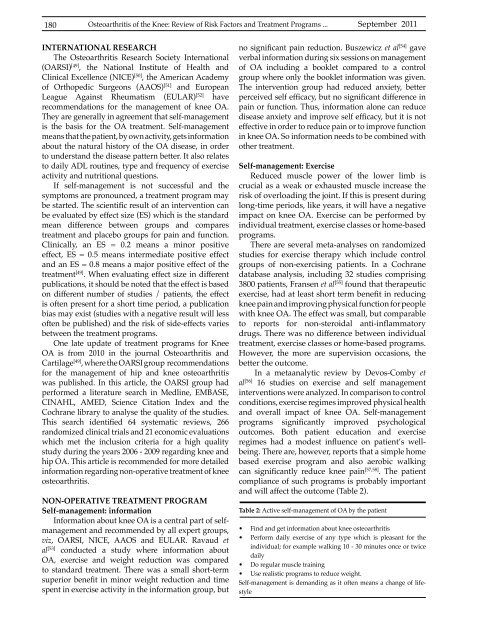Vol 43 # 3 September 2011 - Kma.org.kw
Vol 43 # 3 September 2011 - Kma.org.kw
Vol 43 # 3 September 2011 - Kma.org.kw
You also want an ePaper? Increase the reach of your titles
YUMPU automatically turns print PDFs into web optimized ePapers that Google loves.
180<br />
Osteoarthritis of the Knee: Review of Risk Factors and Treatment Programs ...<br />
<strong>September</strong> <strong>2011</strong><br />
INTERNATIONAL RESEARCH<br />
The Osteoarthritis Research Society International<br />
(OARSI) [49] , the National Institute of Health and<br />
Clinical Excellence (NICE) [50] , the American Academy<br />
of Orthopedic Surgeons (AAOS) [51] and European<br />
League Against Rheumatism (EULAR) [52] have<br />
recommendations for the management of knee OA.<br />
They are generally in agreement that self-management<br />
is the basis for the OA treatment. Self-management<br />
means that the patient, by own activity, gets information<br />
about the natural history of the OA disease, in order<br />
to understand the disease pattern better. It also relates<br />
to daily ADL routines, type and frequency of exercise<br />
activity and nutritional questions.<br />
If self-management is not successful and the<br />
symptoms are pronounced, a treatment program may<br />
be started. The scientific result of an intervention can<br />
be evaluated by effect size (ES) which is the standard<br />
mean difference between groups and compares<br />
treatment and placebo groups for pain and function.<br />
Clinically, an ES = 0.2 means a minor positive<br />
effect, ES = 0.5 means intermediate positive effect<br />
and an ES = 0.8 means a major positive effect of the<br />
treatment [49] . When evaluating effect size in different<br />
publications, it should be noted that the effect is based<br />
on different number of studies / patients, the effect<br />
is often present for a short time period, a publication<br />
bias may exist (studies with a negative result will less<br />
often be published) and the risk of side-effects varies<br />
between the treatment programs.<br />
One late update of treatment programs for Knee<br />
OA is from 2010 in the journal Osteoarthritis and<br />
Cartilage [49] , where the OARSI group recommendations<br />
for the management of hip and knee osteoarthritis<br />
was published. In this article, the OARSI group had<br />
performed a literature search in Medline, EMBASE,<br />
CINAHL, AMED, Science Citation Index and the<br />
Cochrane library to analyse the quality of the studies.<br />
This search identified 64 systematic reviews, 266<br />
randomized clinical trials and 21 economic evaluations<br />
which met the inclusion criteria for a high quality<br />
study during the years 2006 - 2009 regarding knee and<br />
hip OA. This article is recommended for more detailed<br />
information regarding non-operative treatment of knee<br />
osteoarthritis.<br />
NON-OPERATIVE TREATMENT PROGRAM<br />
Self-management: information<br />
Information about knee OA is a central part of selfmanagement<br />
and recommended by all expert groups,<br />
viz, OARSI, NICE, AAOS and EULAR. Ravaud et<br />
al [53] conducted a study where information about<br />
OA, exercise and weight reduction was compared<br />
to standard treatment. There was a small short-term<br />
superior benefit in minor weight reduction and time<br />
spent in exercise activity in the information group, but<br />
no significant pain reduction. Buszewicz et al [54] gave<br />
verbal information during six sessions on management<br />
of OA including a booklet compared to a control<br />
group where only the booklet information was given.<br />
The intervention group had reduced anxiety, better<br />
perceived self efficacy, but no significant difference in<br />
pain or function. Thus, information alone can reduce<br />
disease anxiety and improve self efficacy, but it is not<br />
effective in order to reduce pain or to improve function<br />
in knee OA. So information needs to be combined with<br />
other treatment.<br />
Self-management: Exercise<br />
Reduced muscle power of the lower limb is<br />
crucial as a weak or exhausted muscle increase the<br />
risk of overloading the joint. If this is present during<br />
long-time periods, like years, it will have a negative<br />
impact on knee OA. Exercise can be performed by<br />
individual treatment, exercise classes or home-based<br />
programs.<br />
There are several meta-analyses on randomized<br />
studies for exercise therapy which include control<br />
groups of non-exercising patients. In a Cochrane<br />
database analysis, including 32 studies comprising<br />
3800 patients, Fransen et al [55] found that therapeutic<br />
exercise, had at least short term benefit in reducing<br />
knee pain and improving physical function for people<br />
with knee OA. The effect was small, but comparable<br />
to reports for non-steroidal anti-inflammatory<br />
drugs. There was no difference between individual<br />
treatment, exercise classes or home-based programs.<br />
However, the more are supervision occasions, the<br />
better the outcome.<br />
In a metaanalytic review by Devos-Comby et<br />
al [56] 16 studies on exercise and self management<br />
interventions were analyzed. In comparison to control<br />
conditions, exercise regimes improved physical health<br />
and overall impact of knee OA. Self-management<br />
programs significantly improved psychological<br />
outcomes. Both patient education and exercise<br />
regimes had a modest influence on patient’s wellbeing.<br />
There are, however, reports that a simple home<br />
based exercise program and also aerobic walking<br />
can significantly reduce knee pain [57,58] . The patient<br />
compliance of such programs is probably important<br />
and will affect the outcome (Table 2).<br />
Table 2: Active self-management of OA by the patient<br />
• Find and get information about knee osteoarthritis<br />
• Perform daily exercise of any type which is pleasant for the<br />
individual; for example walking 10 - 30 minutes once or twice<br />
daily<br />
• Do regular muscle training<br />
• Use realistic programs to reduce weight.<br />
Self-management is demanding as it often means a change of lifestyle
















